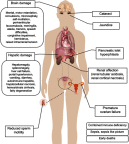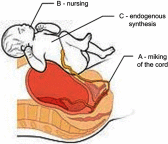Screening for galactosemia: is there a place for it?
- PMID: 31213878
- PMCID: PMC6537461
- DOI: 10.2147/IJGM.S180706
Screening for galactosemia: is there a place for it?
Abstract
Galactose is a hexose essential for production of energy, which has a prebiotic role and is essential for galactosylation of endogenous and exogenous proteins, ceramides, myelin sheath metabolism and others. The inability to metabolize galactose results in galactosemia. Galactosemia is an autosomal recessive disorder that affects newborns who are born asymptomatic, apparently well and healthy, then develop serious morbidity and mortality upon consuming milk that contains galactose. Those with galactosemia have a deficiency of an enzyme: classic galactosemia (type 1) results from severe deficiency of galactose-1-uridylyltransferase, while galactosemia type II results from galactokinase deficiency and type III results from galactose epimerase deficiency. Many countries include neonatal screening for galactosemia in their national newborn screening program; however, others do not, as the condition is rather rare, with an incidence of 1:30,000-1:100,000, and screening may be seen as not cost-effective and logistically demanding. Early detection and intervention by restricting galactose is not curative but is very rewarding, as it prevents deaths, mental retardation, liver cell failure, renal tubular acidosis and neurological sequelae, and may lead to resolution of cataract formation. Hence, national newborn screening for galactosemia prevents serious potential life-long suffering, morbidity and mortality. Recent advances in communication and biotechnology promise facilitation of logistics of neonatal screening, including improved cost-effectiveness.
Keywords: UDP galactose-4-epimerase; galactokinase; galactose-1-phosphate uridylyltransferase; galactosemia neonatal screening; galactosylation.
Conflict of interest statement
The authors report no conflicts of interest in this work.
Figures





References
-
- Lelior LF. The enzymatic transformation of uridine diphosphate glucose into a galactose derivative. Arch Biochem Biophys. 1951;33(2):186–190. - PubMed
-
- Kitagawa H, Shimakawa H, Sugahara K. The tumor suppressor EXT-like gene EXTL2 encodes an α1,4-N-acetylhexosaminyltransferase that transfers N-acetylgalactosamine and N-acetylglucosamine to the common glycosaminoglycan-protein linkage region. The key enzyme for the chain initiation of heparan sulfate. J Biol Chem. 1999;274:13933–13937. - PubMed
LinkOut - more resources
Full Text Sources

